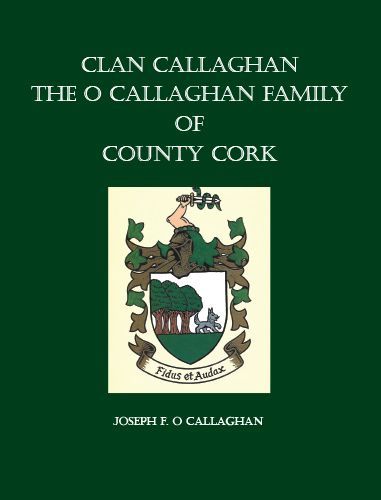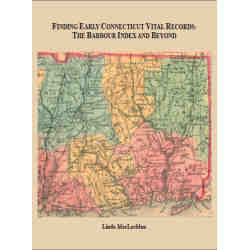
Prior to the 16th Century, the records awaiting determined genealogists and historians are scanty to say the least. Joseph O Callaghan, professor emeritus of medieval history at Fordham University, was certainly better prepared to confront that challenge that most when he tacked his family history. Now available in a revised edition, Clan Callaghan: The O Callaghan Family of County Cork traces the fortunes of that family from its earliest origins in Ireland through the great Irish diaspora of the 18th-20th centuries. His beautifully written and impeccably researched volume should interest not only present-day Callaghans, but also researchers possessing the following allied family names: Barry, Butler, Callaghan, Callahan, Condon, Fitzgerald, Gillman, Gould, Grehan, Lacy, Lismore, Lombard, MacAuliffe, MacCallaghan, MacCarthy, MacSweeney, O Brien, O Connell, O Keeffe, O Mullane, O Neill, O Sullivan, Roche, and White.
Following is an excerpt from Chapter One of Clan Callaghan, where Professor O Callaghan summarizes the fortunes of his ancestors from the 12th through the 15th century, and on the eve of the Tudor incursions into Ireland.
“The genealogy of the O Callaghans of Duhallow recorded in the Book of Munster offers no clues as to the movements of the family during these centuries. According to a generation count, in succession from father to son, Cenede mac Cellacháin, Aodh, and Murchadh lived in the twelfth century. The annals tell us that in 1158 one of the sons of Aodh Ó Cellacháin, perhaps Murchadh, was killed by Brian Ó Briain and Donnchadh Ó Cearbhaill, king of Eoghanacht Locha Lein, a kingdom situated in Kerry about the Lakes of Killarney. Brian and Donnchadh then killed one another, surely a matter of indifference to the dead O Cellacháin.
“In the thirteenth century we have Mathgamhain, Maccrait, and Lochlann. The fourteenth century representatives of the name, in succession from father to son, were Maelseachlann, Maccrait, and Cinnédig. In 1345 McCraygh O Kaillaghan and Donoghwyth Ocaillaghan, – brothers perhaps – joined the MacCarthys, O Mahonys and the forces of the earl of Desmond in ravaging the king’s lands. McCraygh may be identified with the Maccrait just mentioned. Cinnédig had two sons, Donnchadh, who succeeded him as head of the family, and Maelseachlann, whose successors are recorded in the Book of Munster as follows: Domhnall, Maelseachlann, Conchubhar, Diarmaid, and Donnchadh an Oileáin, of the Island, who was living in 1600, and married Eilis Ní h-Uaithne. With Cinnédig’s son Donnchadh and his son Conchubhar Laighneach we pass from the fifteenth into the sixteenth century. Conchubhar Laighneach, who was living in 1469, married Ellen FitzGibbon and had two sons, Tadhg Ruadh and Maccrait. The latter’s descendants are recorded as Cathaoir, Tadhg, Diarmaid, and Cathaoir. More will be said of Tadhg Ruadh in the following chapter.
“During the Tudor Era, O Callaghan lands extended along both banks of the river from a point slightly to the west of Mallow, to the junction of the Allow and the Blackwater just below Kanturk. Included in this territory were the parishs of Clonmeen and Kilshannig south of the river, part of Ballyclough, Roskeen, and parts of Castlemagner and Dromtariff north of the river. Butler estimated that the O Callaghan territory included at least fifty-one ploughlands or about 6,120 acres. While MacDonough MacCarthy with his chief seat at Kanturk was the O Callaghans’ immediate neighbor to the west, the lands of the Anglo-Irish Barrys and Roches bordered on the east. Barry, as viscount of Buttevant, had his residence there on the Awbeg River, while Roche was lord of Fermoy. The river Clydagh near Mourne Abbey divided O Callaghan holdings from the Roches. O Callaghan territory was commonly called Pobul Uí Cheallacháin, literally, the People of Callaghan, or O Callaghan’s Country. The O Callaghans naturally intermarried with the MacDonoughs, O Keeffes, MacAuliffes, and MacCarthys of Muskerry, but as marriages were a convenient way of cementing political alliances they did not neglect their Anglo-Irish neighbors, the Roches, FitzGeralds, and Barrys.
“The genealogy discussed above is that of the head of the family. As it appears in the Book of Munster, it is a bare list of fathers and sons succeeding one another, without any indication of the dates when they lived or the events in which they participated. In considering the growth of this family, several points should be emphasized. Modern historians have spoken of expanding clans, including the O Callaghans. These were prolific families whose growth in numbers was encouraged by the loose marital bonds prevailing in medieval Ireland, to the extent that one could speak of polygamous relationships. The families that gained in strength were those where fathers had numerous sons, not necessarily by one wife; nor were the sons all legitimate, as one usually understands that term, though there was no stigma attached to illegitimacy. One must also suppose that along with many sons, there were many daughters, but neither they nor their mothers were recorded in the genealogies. Only in the early modern period do we encounter the names of the chieftains’ wives. Wives were likely chosen with a view to cementing alliances with other important families. Given the tendency of chieftains to engage in numerous liaisons with women, whether sanctioned by the church or not, it is probable that each of the medieval heads of the family had other sons and daughters who are not recorded in the genealogy. Ultimately all of them derived from Cellachán of Cashel. Only in this way can one explain the growth of the family over the centuries and its ability to take over and dominate a significant stretch of land along the Blackwater in northwest Cork.”





